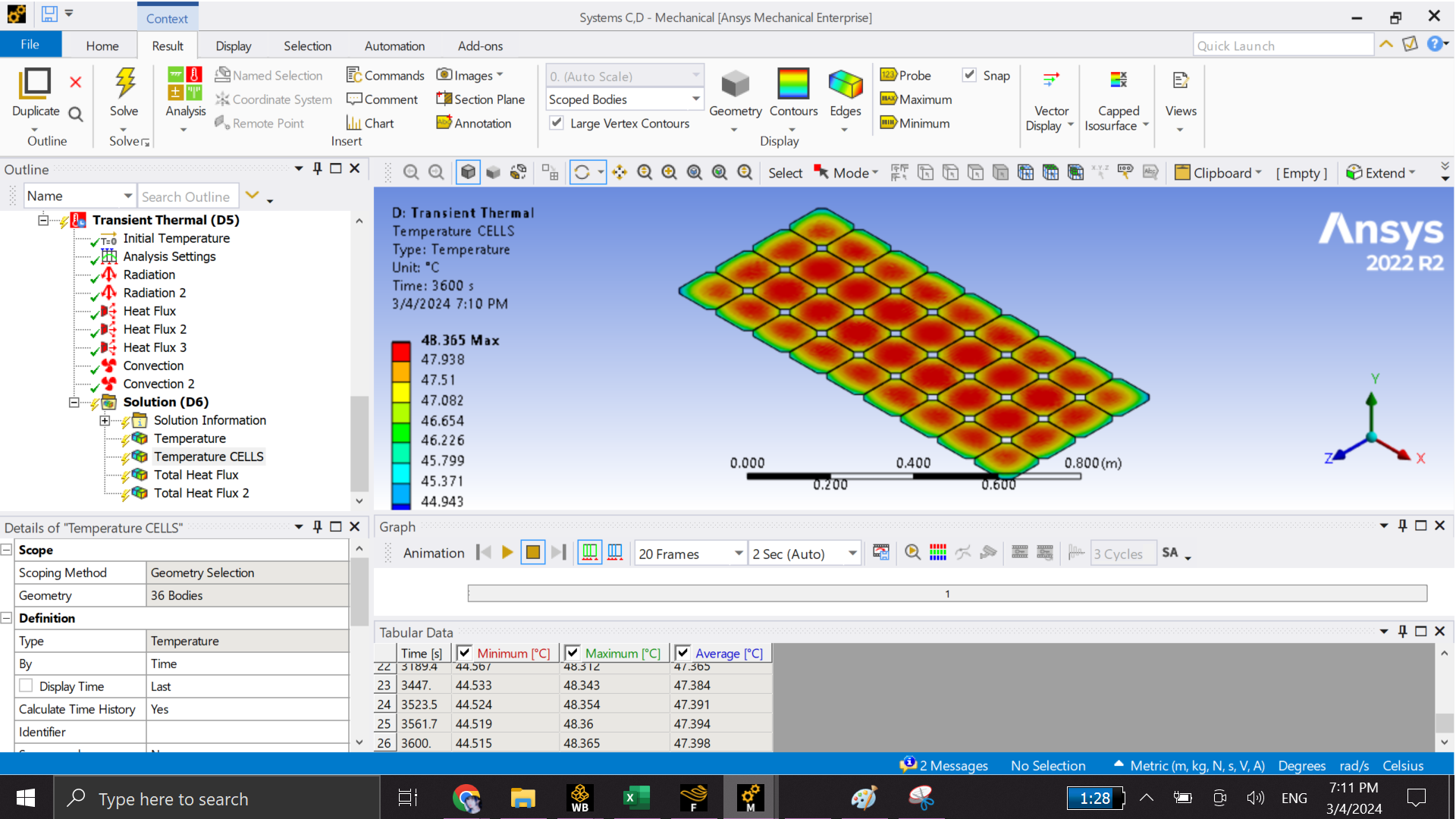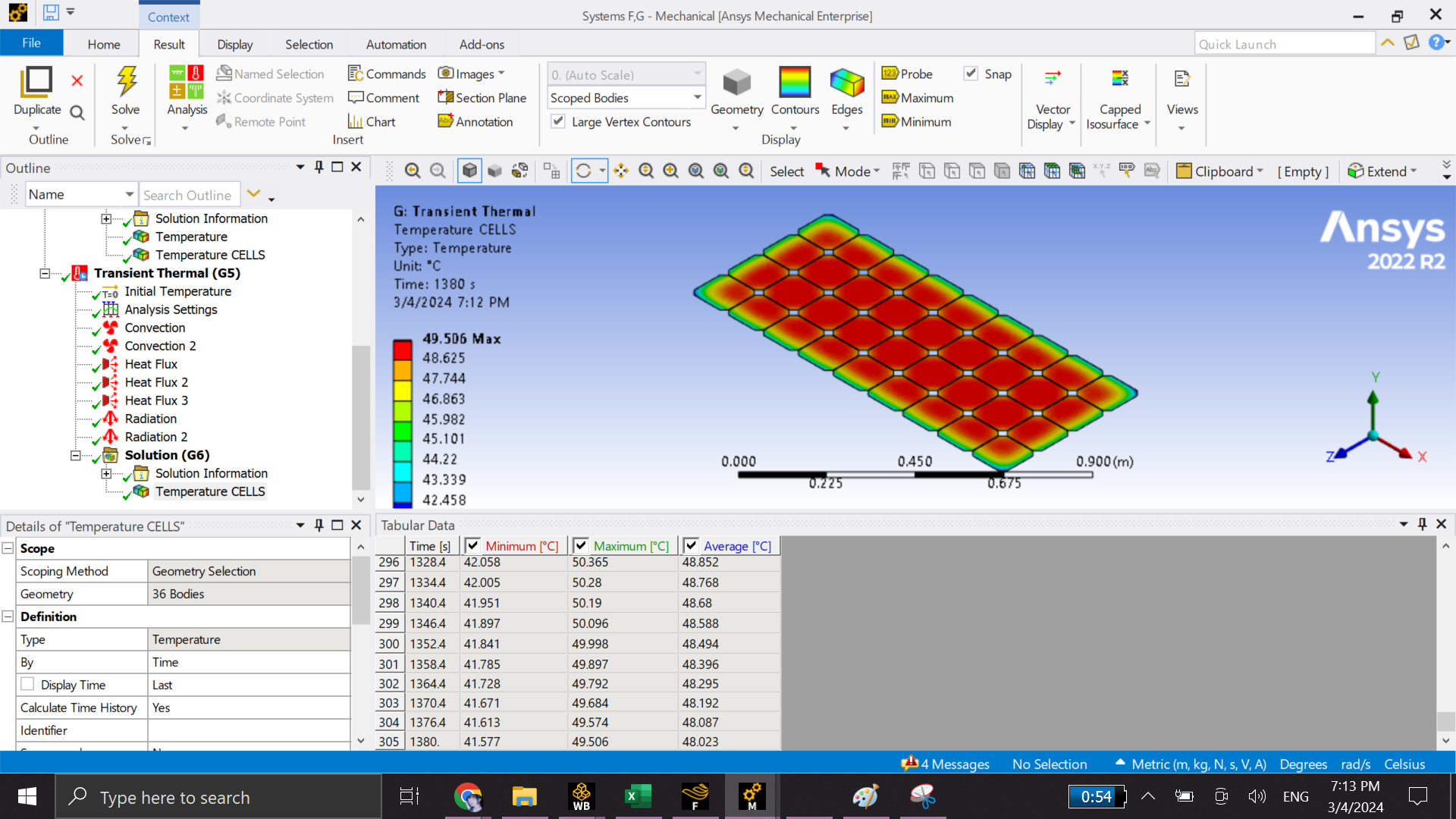TAGGED: ansys-transient-thermal
-
-
February 29, 2024 at 1:21 pm
noor bghs
SubscriberHi !
I've been trying to simulate the cooling of a solar panel using Fluent Flow, a steady state thermal and a transient thermal. What I did was create the geometry of the solar panel before conducting a thermal analysis (a steady state thermal at first, and then a transient thermal analysis to see the temperatures of the solar panel over time). After that, I used Fluent Flow to create a channel below and above the solar panel, the below chanel meant to represent a conduite for air cooling, and the above channel is meant to represent the flow of water above the solar panel. Both of these were done in two separate projects and I introduced the solution from Fluent Flow as the setup for the steady state thermal analysis (to achieve the cooling).
Both methods worked when I redid the steady state thermal analysis, and they worked for the transient thermal analysis too, but only for short periods of time. For some reason, when I try to simulate the transient thermal analysis for longer periods of time (twenty-three hours, to be specific) the cooling isn't working anymore and the analysis results showcases temperatures that are similar to the non-cooled solar panel. I asked a couple of people and they said the cooling is supposed to work, even for longer periods of time, but for some reason, I am not getting those results.
Any idea as to why this could be?
The analysis setup for the solar panel includes two convection settings (one for the bottom layer of the solar panel and one for the top layer) as well as radiation settings (for those two layers as well) as well as heat flux for three other layers.
If anyone could help me with this, I'd appreciate it a whole lot!
-
March 4, 2024 at 11:29 am
Ashish Khemka
Forum ModeratorHi,
Can you share the snapshot of the setup? What is happening after short period of time, is any boundary condition or load changing?
Regards,
Ashish Khemka
-
March 4, 2024 at 6:29 pm
noor bghs
SubscriberHi ! Thank you so much for replying and of course !
This is the solar panel cells pre-cooling for 3600s.
This is the solar panel cells post-cooling for only 1380s. (The temperature is higher than that of the non-cooled cells)
Ideally, i’d like to set up (and I’ve tried to) the boundary conditions (Convection, radiation) as being time variable and have varying temperatures (For each heat transfer coefficient there is a temperature) and i’ve tried to do so but the results have been as you have seen above.
Below are the screenshots for the setup for convection and radiation respectively.
As for the cooling method itself, I used this specific tutorial. Basically, I created the geometry of the solar panel and then ran a steady state and transient thermal analysis. The temperature came out to about 50 degrees Celsius. After that, using fluent flow, I created a cooling chamber/conduite type thing below the solar panel and it contains air that is 25 degrees celsius in temperature and has a velocity of 3m/s. After that, I imported the results from fluent flow into a steady state thermal, imported that temperature and then ran a transient thermal analysis with the boundary conditions (convection, heat flux, radiation) and it worked out well for 60s. The 50 degrees celsius dropped to around 34 degrees celsius.
I thought it was an interesting approach and wanted to try it with a different set of parameters. Since it worked for 60s, I don’t see why it wouldn’t work for longer periods of time.
If you’d like, I can redo the results for 60s and send them over just so everything is clearer. I hope the way I described this makes sense. I’m pretty new to using Ansys so this is most likely a problem on my end rather than the methodology itself.
Also, the temperature maximum and minimum plots differ greatly. On the “cooled” panel, the temperature maximum and minimum both go up, and on the non-cooled panel, they go down, so maybe it’s that? I also thought about the problem being a time-step issue but I really don’t know.
Also !! I forgot to answer your question. The boundary conditions are varying in terms of time, like I showed above. As for the temperature load, it's essentially the same. I'm not sure if the varying convection and temperature settings are what's causing the issue as I've tried to vary those parameters on smaller times and everything worked out fine so I'm not really sure.
-
- The topic ‘Cooling of a solar panel in Mechanical using transient thermal’ is closed to new replies.



-
4678
-
1565
-
1386
-
1241
-
1021

© 2025 Copyright ANSYS, Inc. All rights reserved.







